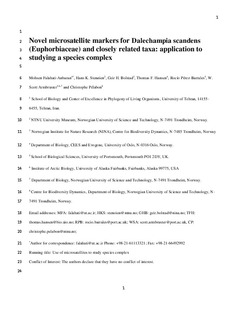| dc.contributor.author | Falahati-Anbaran, Mohsen | |
| dc.contributor.author | Stenøien, Hans K. | |
| dc.contributor.author | Bolstad, Geir Hysing | |
| dc.contributor.author | Hansen, Thomas F | |
| dc.contributor.author | Pérez‐Barrales, Rocio | |
| dc.contributor.author | Armbruster, William Scott | |
| dc.contributor.author | Pelabon, Christophe | |
| dc.date.accessioned | 2016-10-11T10:46:27Z | |
| dc.date.accessioned | 2016-10-17T11:45:43Z | |
| dc.date.available | 2016-10-11T10:46:27Z | |
| dc.date.available | 2016-10-17T11:45:43Z | |
| dc.date.issued | 2016 | |
| dc.identifier.citation | Plant Species Biology 2016 | nb_NO |
| dc.identifier.issn | 1442-1984 | |
| dc.identifier.uri | http://hdl.handle.net/11250/2415533 | |
| dc.description.abstract | We developed novel microsatellite markers for D alechampia scandens L. (Euphorbiaceae). The target plants belong to a distinct, but undescribed, species in the D . scandens species complex, characterized by small resin-producing glands. In total, 110 alleles over 36 novel markers were identified across 39 individuals from three populations. The number of alleles varied from one to seven, with an average of 3.06 ± 0.26 alleles per locus. The developed markers, along with previously developed ones for a large-glanded D . scandens species, were tested for amplification in 11 additional species of the genus D alechampia. Four markers did not produce any detectable allele in 37 individuals from two populations of the large-glanded species. Average expected heterozygosity across all small- and large-glanded specific loci was 0.36 and 0.15, for the small and large glanded populations, respectively. Cross-species amplification showed that 89% of all markers were successfully amplified in at least one of the 11 other D alechampia species. These microsatellite markers may be useful for detecting undescribed species in the D . scandens species complex, and can be used for comparative analyses of genetic structure, mating system and phylogeography of other D alechampia species. | nb_NO |
| dc.language.iso | eng | nb_NO |
| dc.publisher | Wiley | nb_NO |
| dc.title | Novel microsatellite markers for Dalechampia scandens(Euphorbiaceae) and closely related taxa:application to studying a species complex | nb_NO |
| dc.type | Journal article | nb_NO |
| dc.type | Peer reviewed | nb_NO |
| dc.date.updated | 2016-10-11T10:46:27Z | |
| dc.source.journal | Plant Species Biology | nb_NO |
| dc.identifier.doi | 10.1111/1442-1984.12142 | |
| dc.identifier.cristin | 1390134 | |
| dc.description.localcode | This is the peer reviewed version of the following article: [FULL CITE], which has been published in final form at doi:10.1111/1442-1984.12142. This article may be used for non-commercial purposes in accordance with Wiley Terms and Conditions for Self-Archiving." | nb_NO |
